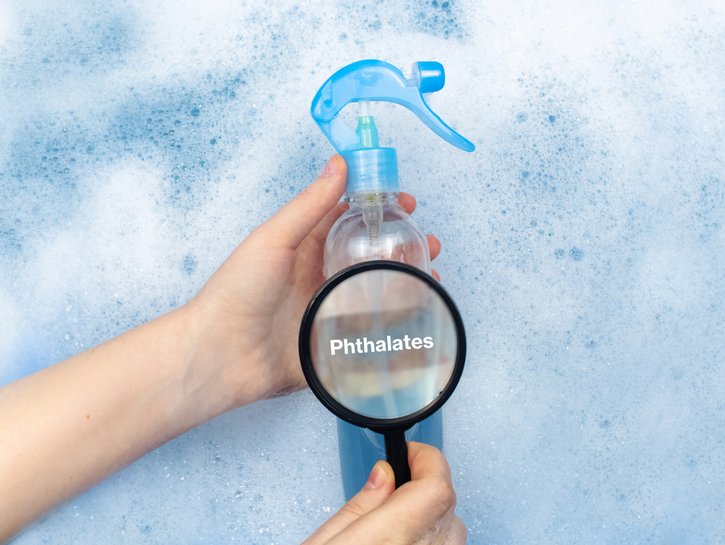We all know that there are numerous chemicals with names we can’t pronounce that are part of everything in our daily lives. From the food we eat to the building materials in our homes to the beauty products we use. It’s time we talk about phthalates (THAL-ates).
What the Phuck are Phthalates?

You can’t see them. You can’t smell or taste them. But phthalates are in literally hundreds of products that you use each and every day. They are also in your food. According to the CDC, phthalates–or plasticizers–are a group of chemicals that are used to make plastics more durable.
Some phthalates are used to help dissolve other materials. There are also phthalates in polyvinyl chloride plastics which are used to make things like medical tubing, plastic packaging, and garden hoses.
You can find phthalates in personal care products like soaps, shampoos, hair sprays, nail polish, and skin moisturizers. They’re also in detergents, adhesives, lubricants, insecticides, building materials, and vinyl flooring.
Phthalates Are In Your Body, Too

Phthalates are in meat and dairy products, as well as fast food. They’re even in your body! Ami Zota, an assistant professor of environmental and occupational health at George Washington University, says that nearly half of Americans have phthalate byproducts in their urine.
They get into your body through dairy and meat from animals that have been exposed, the cosmetics you use, and the food and beverages you consume that are served or packaged in plastic that has phthalates.
You’re more likely to be exposed to phthalates if you work in painting, printing, or plastics processing. People with medical conditions like kidney disease or hemophilia also have a higher risk of exposure. This is because IV tubing and other medical supplies are made with phthalates.
Are Phthalates Harmful?

There has been a lot of research in recent years in the world of phthalates, but we’re still learning about how they truly affect us. What’s still a mystery is how they act with other chemicals.
“Very often, it’s not just one phthalate that causes a problem. The chemicals in consumer products and food work in combination, just as they do in our medications,” Dr. William Rea, Director of the Environmental Health Center in Dallas, explains.
In 2014, California added the phthalate DINP to its list of chemicals known to cause cancer. Phthalates were also included in the Consumer Product Safety bill that Congress passed in 2008. That bill banned the use of some phthalates in kid’s products, passed an interim ban on others and required that the Consumer Product Safety Commission take a closer look at this group of chemicals.
Some research has suggested a link between phthalates and the rising rates of chronic disease. It’s also evident that they affect different groups of people in different ways. It’s difficult to know how safe or harmful phthalates are because they aren’t a single chemical. Instead, they’re an entire family.
Three phthalates–BBP, DBP, and DEHP–have already been banned from toys and products made for children under three. Especially those that help kids sleep, eat, teethe, and suck. In testing on lab rats, DBP and DEHP have been shown to damage reproductive systems. Especially in males.
There’s also evidence of a link to cancer in lab rats, but not confirmed in people. The way phthalates affect animals is different to how they affect humans. This is another reason why the research makes it difficult to know just how harmful phthalates are.
Three more phthalates–DiDP, DINP, and DnOP–have been temporarily banned from toys that can go into a child’s mouth. They’ve been known to make eyes and skin red or cause nausea, dizziness, and vomiting.
Researchers have also linked phthalates to asthma, attention-deficit hyperactivity disorder, breast cancer, obesity and type II diabetes, low IQ, neurodevelopmental issues, behavioral issues, autism spectrum disorders, altered reproductive development, and male fertility issues.
Who’s At Risk?

According to WebMD, the group who’s most at risk when it comes to phthalates are unborn babies and children. They appear to do the most harm to males. Kids in puberty are also at a higher risk because “times of biological transformation seem to leave us vulnerable to these chemicals,” Zota says.
Adult women tend to have more side effects than men when exposed to phthalates. This is probably because of the use of cosmetics and personal care products.
Because there are still so many unknowns when it comes to phthalates, it’s best to proceed with caution and avoid harmful phthalates as much as possible. Our bodies do have a natural detoxifying system, but keeping exposure to a minimum is wise.
Check out product labels–especially when buying items for kids or personal care products–to see if phthalates are included. When they are identified on labels, you’ll probably see acronyms like DHEP or DiBP. Some products are labeled “phthalate-free.”
Another way to avoid phthalates is to cut fast food out of your diet because those containers are a source of harmful exposure, according to researchers. Also, if your diet is high in dairy and meat, you could have a high level of exposure to phthalates. The truth is, though, that phthalates are impossible to avoid. They are everywhere in everything.
If they wanted to, lawmakers and regulators could have phthalates removed altogether from products with no replacement. This is according to “green” chemist Bruce Akers. The problem, however, is that these chemicals are used to create tubing or packaging. This makes eliminating them extremely difficult.
“If you want soft, squeezable plastic, you’re using phthalates,” Akers says.
The academic studies and policy reports about the health impacts of phthalates are consistently sounding the alarm about the possible risks. Consumers are also starting to recognize the harm that phthalates could cause, which means more regulation and legislation on the state and federal level could be coming. Just remember, at this point, companies are not required to list phthalates on consumer product labels. It’s up to you to keep your exposure to a minimum.
